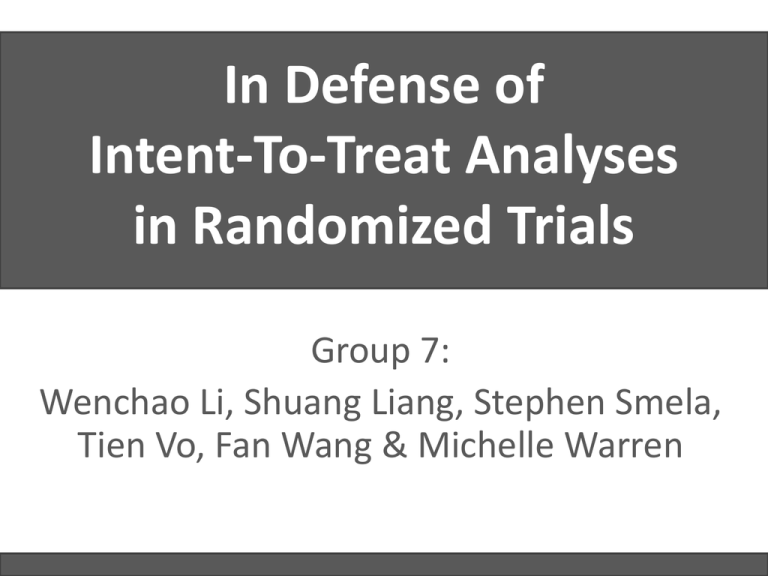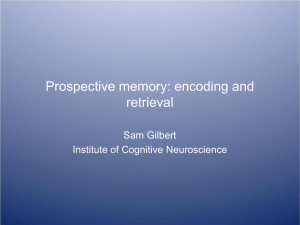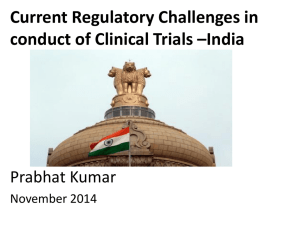
In Defense of
Intent-To-Treat Analyses
in Randomized Trials
Group 7:
Wenchao Li, Shuang Liang, Stephen Smela,
Tien Vo, Fan Wang & Michelle Warren
Proposition
The primary analysis of randomized trials
should always be intention-to-treat.
To ensure that this analysis can be carried
out, data collection following treatment
discontinuation through the end of the trial
should be a protocol requirement.
Intent-to-Treat
• An analysis in which patients are included in the
group to which they were randomized irrespective
of compliance, administrative errors (e.g., error in
eligibility), or other protocol deviations.
• International Conference on Harmonization (ICH)
guidelines use the term "full analysis" set to refer
to the set of all patients randomized.
• Can be viewed as a comparison of treatment
policies.
Per-Protocol / As-Treated
• An analysis in which patients are included in the
group corresponding to the treatment they actually
received. Patient compliance and "switchovers" are
considered in the analysis.
• Typically, in a "per protocol" analysis, patients who
do not meet all of the eligibility criteria or do not
adhere to the protocol are excluded, and events
that occur after treatment discontinuation are
excluded.
• ICH guidelines use the term "per protocol" to
define a group of patients who were "adherent" to
the protocol.
Why Do ITT?
Generalizability
• In “real life” uptake of an intervention will
never be “per-protocol”
– It’s important to know that the intervention will
still work, despite human error!
• PP analyses are based on a subset of
participants
– Results may not generalize to the population from
which the original sample was taken
Preserving Randomization
• Reasons for attrition/non-adherence may be
different across arms
– Excluding people from the analysis accordingly
may introduce confounding effects
• The effect obtained via PP analysis reflects
some combination of treatment effect and
subset selection bias[2]
– It’s impossible to disentangle the two
Loss of Power
Is Loss of Power Really an Issue?
• PP analyses can also result in loss of power by
reducing the number of observations available
• Whether ITT results in loss of power is an
empirical question
– In fact, studies have found that ITT analyses can
result in larger treatment effects being observed
than PP analyses[1]
Combatting Loss of Power
• Improve adherence protocols
• Increase sample size
Missing Data
Combatting Missing Data
• Planning to not collect the data is not a solution
– As we have seen in class, halting data collection at
treatment discontinuation may result in missing long-term
effects of the treatment that arise even after treatment
stops[2]
• Improve retention protocols
• Develop a plan for missing data[1,2]
– [Multiple] Imputation
– Carry last observation forward
– Instrumental variables, other statistical techniques
But Can the Treatment Work?
20/20 Hindsight
• You can always conduct secondary analyses
– If data collection is stopped because of protocol
non-adherence, then only PP analyses are
possible[2, 4]
• If participants contribute follow-up data
irrespective of any protocol violation, both ITT
and PP analyses can be performed
References
1. Have TRT, Normand ST, Marcus SM, Brown CH, Lavori PL,
Duan N. Intent-to-treat vs. non-intent-to-treat analyses
under treatment non-adherence in mental health
randomized trials. Psychiatr Ann 2008; 38(12): 772-783.
2. Lachin JM. Statistical considerations in the intent-to-treat
principle. Controlled Clinical Trials 2000; 21: 167-189
3. Little R, Yao L. Intent-to-treat analysis for longitudinal
studies with drop-outs. Biometrics 1996; 52(4): 13241333.
4. Nich C, Carroll KM. ‘Intention-to-treat’ meets ‘missing
data’: implications of alternate strategies for analyzing
clinical trials data. Drug Alcohol Depend 2002; 68: 121130.
16
Intent To Treat
“THE PRIMARY ANALYSIS OF RANDOMIZED
TRIALS SHOULD ALWAYS BE INTENTION-TOTREAT AND TO ENSURE THIS ANALYSIS CAN
BE CARRIED OUT, DATA COLLECTION
FOLLOWING TREATMENT DISCONTINUATION
THROUGH THE END OF THE TRIAL SHOULD BE
A PROTOCOL REQUIREMENT.”
Group 8:
Zhiyuan Xu, Yiwen Zhang, Chelsea Nichols, Lu Wang, Nadir
Demirel, Travis Myers
Arguments Against Intent
to Treat
In Intent to Treat analysis there is no
way to efficiently statistically
evaluate compliance
Evaluation of trials of efficacy
(Pragmatic trials) versus trials of
method (exploratory trials)
The distinction is probably most heated in
Pharmaceutical Trials where the desired
information is whether or not the drug is
effective in the population taking/able to take
the drug.
17
Non Compliance and
Intent to Treat
The impact of non-compliance on the
intent-to-treat estimate in a comparison
of active drugs is more complex.
For example Let Drug A be equivalent or
inferior to Drug B. Then assume that Drug A is
very unpleasant to take, leading to lower
compliance to Drug A than to Drug B. In this
case, the intent-to-treat will overestimate the
‘pure’ treatment benefit of Drug B (although
one can argue that this is appropriate given
B’s superior tolerability).
The ITT estimate of treatment effect in a
placebo-controlled trial is clearly diluted
by non-compliance, if there is no
18
Against Intent to Treat
Cont’d
Argued
To
in Non-inferiority Trials
demonstrate that a new
treatment is not inferior to a
control, one should determine an
amount of inferiority, frequently
called the margin, that is
unacceptable.
19
Non-inferiority Trials
To ensure that a successful trial
demonstrates that the study treatment
has at least some efficacy, this margin
must be no greater than the smallest
effect one is confident that the active
control has, for example, the top of
the confidence limit in bar A. One
then sets a null hypothesis of inferiority
by that amount or more and designs a
trial to reject the null hypothesis.
20
Non-inferiority Trials
An intent-to-treat analysis may tend
to lead to a conclusion of noninferiority for a drug that is truly
inferior to the active control among
compliers.
This fear has led to some reliance
on per-protocol analyses for noninferiority designs.
21
Alternatives to Intent to
Treat
Method-effectiveness
Models
The most popular is “per-protocol”
method
The
patients are evaluated for the
treatment they complete
The per protocol alternative to the
intention-to-treat method may be
practical where evidence-based
medicine and individual patient
care converge.
22
Examples of Applications
Subgroup and Per-Protocol Analysis of
the Randomized European Trial on
Isolated Systolic Hypertension in the
Elderly
In 1989, the European Working Party on High Blood
Pressure in the Elderly started the double-blind,
placebo-controlled, Systolic Hypertension in Europe
Trial to test the hypothesis that antihypertensive drug
treatment would reduce the incidence of fatal and
nonfatal stroke in older patients with isolated systolic
hypertension. This report addresses whether the benefit
of antihypertensive treatment varied according to sex,
previous cardiovascular complications, age, initial
blood pressure (BP), and smoking or drinking habits in
an intention-to-treat analysis and explores whether the
morbidity and mortality results were consistent in a perprotocol analysis.
23
Other Recommendations
The European Committee for
Proprietary Medicinal Products
Points to Consider document
indicated that for a superiority trial,
the intent-to-treat analysis should
be considered primary and the perprotocol supportive; but for a noninferiority trial, the analyses are
equally important.
24
A Recap of the ITT Lecture
Points
Primary analysis should usually be ITT (need to continue
collecting data to do this right) – it addresses a pragmatic
policy/management question which is always relevant.
ITT analysis requires excellent trial conduct.
It is appropriate to carry out secondary “per protocol” or
“as treated” analyses but these have to be interpreted
with caution.
For analyses which are not intent-to-treat it is often
difficult/impossible to quantify bias resulting from not
comparing like with like
If exclusions after randomization are to be made as part of
secondary “per protocol” analyses, they should be
specified in the protocol
Think about what you want to estimate in advance.
25
Sources
CPMP. Points to Consider on switching between superiority
and non-inferiority July 2000.
http://www.emea.eu.int/pdfs/human/ewp/048299en.pdf
Brittain E. et Lin, D. Statist. Med. 2005; 24:1–10
Prescrire Int. 2012 Dec;21(133):304-6.
http://www.ncbi.nlm.nih.gov/pubmed/23373104
Staessen JA, Fagard R, Thijs L, et al. Subgroup and PerProtocol Analysis of the Randomized European Trial on
Isolated Systolic Hypertension in the Elderly. Arch Intern
Med. 1998;158(15):1681-1691.
doi:10.1001/archinte.158.15.1681.
Lachin, John M. "Statistical considerations in the intent-totreat principle."Controlled clinical trials 21.3 (2000): 167-189.
Sheiner, Lewis B., and Donald B. Rubin. "Intention-to-treat
analysis and the goals of clinical trials*." Clinical
Pharmacology & Therapeutics 57.1 (1995): 6-15.
26










